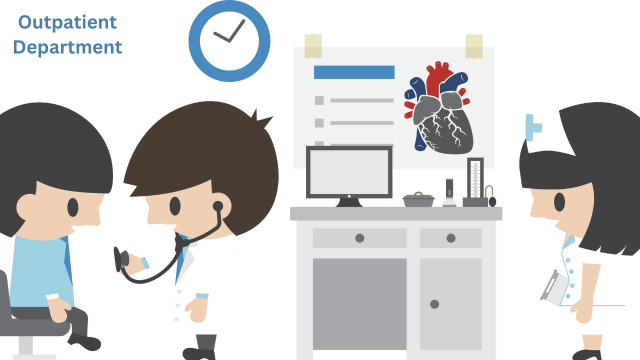In the realm of healthcare, understanding the terminology used can greatly enhance patient comprehension and care. One commonly encountered term is OPD. So, what does OPD stand for? OPD stands for “Outpatient Department,” a crucial part of hospitals and clinics that provides medical services to patients who do not require overnight hospitalization. This blog post aims to offer a detailed overview of the OPD full form, its significance, and various aspects of outpatient services.
What Does OPD Stand For?
OPD stands for “Outpatient Department.” It is a critical component of hospitals and clinics, designed to provide medical care and services to patients who do not require an overnight stay. The OPD is where patients receive consultations, diagnostic services, treatments, and follow-up care without being admitted to the hospital.
Structure and Function of the OPD
1. Structure of the OPD
The Outpatient Department is typically organized to handle a large volume of patients efficiently. It is divided into various sections to cater to different medical needs, including:
- Consultation Rooms: Where patients meet with doctors for examinations and discussions.
- Diagnostic Laboratories: For tests such as blood work, urinalysis, and other diagnostic procedures.
- Imaging Facilities: Including X-rays, MRIs, and CT scans, essential for accurate diagnosis.
- Pharmacy: For dispensing medications prescribed by doctors.
- Registration and Billing: Where patients are registered and billing information is processed.
2. Functions of the OPD
The primary functions of the OPD include:
- Initial Consultations: Providing the first point of contact for patients seeking medical advice or treatment.
- Follow-Up Care: Managing ongoing treatment plans and monitoring progress for chronic conditions.
- Diagnostic Testing: Conducting various tests to aid in accurate diagnosis and treatment planning.
- Minor Procedures: Performing non-surgical interventions and treatments that do not require hospitalization.
- Health Education: Offering guidance and information on health management and preventive care.
Benefits of the OPD
The Outpatient Department offers several benefits to both patients and healthcare systems:
- Cost-Effective Care: By avoiding overnight stays, patients incur lower medical expenses, and healthcare facilities reduce costs associated with inpatient care.
- Efficiency: OPDs streamline the process of medical consultations and treatments, reducing waiting times for patients and enabling healthcare providers to manage their time effectively.
- Convenience: Patients can receive care and return home on the same day, which is particularly beneficial for those with non-severe conditions or chronic diseases.
- Specialized Care: OPDs often include specialized clinics (e.g., cardiology, dermatology), allowing for focused care and expertise in various medical fields.
Common Procedures and Services in the OPD
1. Consultations
Patients visit the OPD for consultations with general practitioners or specialists. During these visits, doctors assess symptoms, provide diagnoses, and propose treatment plans. Follow-up appointments may be scheduled to monitor the patient’s progress.
2. Diagnostic Tests
OPDs facilitate a range of diagnostic tests to determine the underlying causes of symptoms. Common tests include blood tests, urine tests, imaging studies (like X-rays and MRIs), and other specialized assessments.
3. Minor Surgical Procedures
Some OPDs are equipped to perform minor surgical procedures that do not require hospitalization. Examples include skin biopsies, minor wound repairs, and certain endoscopic procedures.
4. Preventive Care
Preventive services, such as vaccinations, health screenings, and wellness checks, are also provided in the OPD. These services aim to detect potential health issues early and promote overall well-being.
Challenges and Considerations
While OPDs play a vital role in healthcare delivery, they face several challenges:
- High Patient Volume: OPDs often experience high patient volumes, leading to longer wait times and potential delays in care.
- Resource Constraints: Limited resources and staffing issues can impact the efficiency and quality of care provided.
- Coordination with Inpatient Services: Ensuring smooth transitions between outpatient and inpatient care when necessary requires effective communication and coordination among healthcare providers.
Future Directions
The future of OPD services is likely to involve several advancements:
- Telemedicine Integration: The rise of telemedicine offers the potential for remote consultations and follow-ups, improving accessibility and convenience for patients.
- Enhanced Technology: Innovations in diagnostic and treatment technologies will continue to improve the quality of care delivered in OPDs.
- Patient-Centered Care: There will be a greater emphasis on personalized and patient-centered approaches, focusing on individual needs and preferences.
FAQs
1. What is the difference between OPD and IPD?
OPD (Outpatient Department) provides care for patients who do not require overnight hospitalization, while IPD (Inpatient Department) involves admission to the hospital for overnight stays or longer-term care. OPD deals with consultations, minor procedures, and follow-ups, whereas IPD handles more complex cases that require extended monitoring and treatment.
2. Can I get emergency care in the OPD?
While OPDs are designed for non-emergency care, many hospitals have separate emergency departments (ED) for urgent and critical situations. If you require immediate and intensive care, it is best to visit the ED or call emergency services.
3. How do I prepare for an OPD visit?
To prepare for an OPD visit, ensure you have relevant medical records, a list of current medications, and any previous test results. Arriving early for registration and having your insurance details handy can also facilitate a smoother process.
4. Are OPD services covered by insurance?
Most health insurance plans cover OPD services, though coverage details can vary. It is advisable to check with your insurance provider regarding the extent of coverage for consultations, diagnostic tests, and other outpatient services.
5. How can I manage long wait times in the OPD?
Managing wait times can be challenging. Consider scheduling appointments during less busy times, bringing reading material or electronic devices to pass the time, and staying in touch with hospital staff for updates on your appointment status.
Conclusion
The Outpatient Department (OPD) is an indispensable part of the healthcare system, offering a wide range of services to patients who do not need to be hospitalized. By understanding what OPD stands for and how it functions, patients and caregivers can better navigate healthcare services and make informed decisions about their medical care. With ongoing advancements and a focus on patient-centered care, OPDs will continue to play a crucial role in delivering accessible, efficient, and high-quality healthcare.











